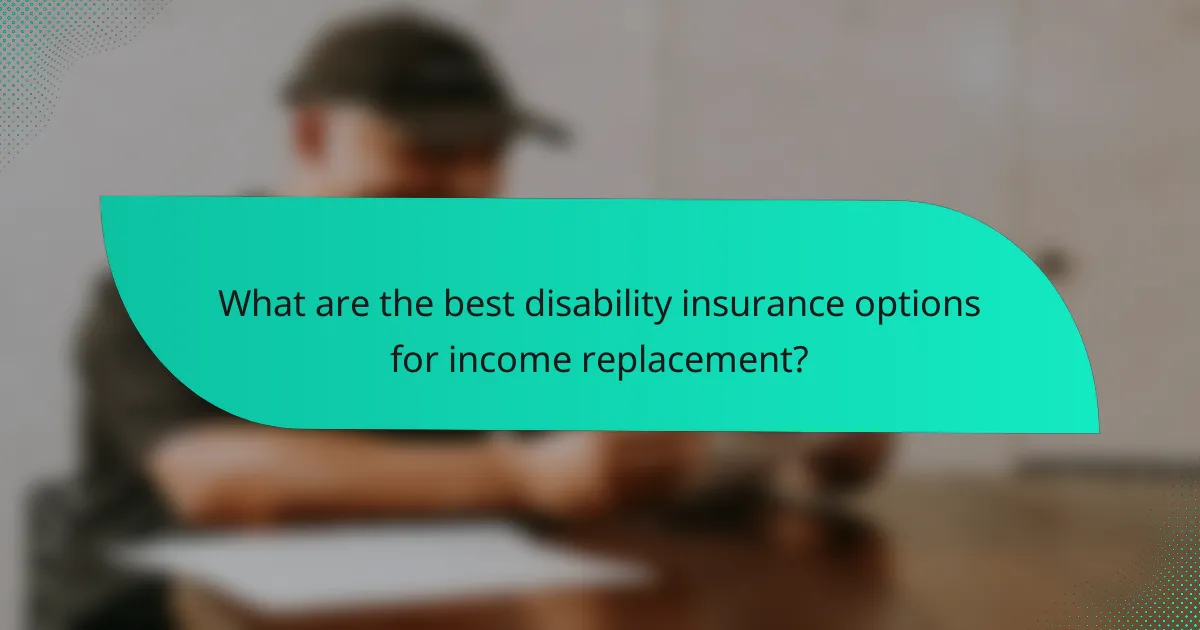Disability insurance is essential for income replacement when unforeseen medical conditions prevent individuals from working. It encompasses both short-term and long-term coverage options, each designed to meet varying needs and circumstances. Short-term policies offer temporary financial support, while long-term options provide extended income replacement for prolonged disabilities.

What are the best disability insurance options for income replacement?
The best disability insurance options for income replacement include short-term and long-term policies, as well as employer-sponsored and private plans. Each option has unique features and benefits that cater to different needs and circumstances.
Short-term disability insurance
Short-term disability insurance provides income replacement for a limited period, typically ranging from a few weeks to six months. This type of coverage is ideal for temporary illnesses or injuries that prevent you from working.
Benefits usually cover a percentage of your salary, often around 60-70%, and may begin after a brief waiting period. It’s essential to review the policy details to understand the duration of benefits and any exclusions.
Long-term disability insurance
Long-term disability insurance offers coverage for extended periods, often lasting several years or until retirement age. This insurance is crucial for serious health issues that could impact your ability to work for an extended time.
Policies typically replace a portion of your income, usually between 50-70%, and may have a waiting period before benefits begin. Consider the terms carefully, including the definition of disability and any potential offsets for other income sources.
Employer-sponsored plans
Employer-sponsored disability insurance plans are often provided as part of employee benefits packages. These plans can include both short-term and long-term coverage, usually at a lower cost than private options.
While convenient, it’s important to assess the coverage limits and terms, as employer plans may not fully replace your income. Review your employer’s policy to ensure it meets your needs and consider supplementing it with additional coverage if necessary.
Private disability insurance
Private disability insurance is purchased independently and can be tailored to your specific needs. This option allows for greater flexibility in terms of coverage limits and waiting periods.
When selecting a private policy, compare features such as benefit duration, elimination periods, and the percentage of income replaced. Investing in a comprehensive private plan can provide peace of mind, especially for high-income earners.
State disability programs
State disability programs offer income replacement for eligible individuals who are unable to work due to non-work-related injuries or illnesses. These programs vary by state, with some providing short-term benefits and others offering long-term support.
Eligibility requirements and benefit amounts differ, so it’s crucial to check your state’s specific regulations. Many states require contributions from employees, and understanding these programs can help you maximize your income replacement options.

How does short-term disability insurance work?
Short-term disability insurance provides income replacement for a limited period when an individual is unable to work due to a medical condition. This type of coverage typically kicks in after a brief waiting period and lasts for a few weeks to several months, depending on the policy.
Coverage duration
Short-term disability insurance generally covers a period ranging from a few weeks up to six months. The exact duration depends on the specific policy and the nature of the disability. Some plans may offer benefits for as little as 30 days, while others extend coverage to 26 weeks.
It’s crucial to understand the waiting period before benefits begin, which can vary from one to two weeks. This means that individuals may need to manage their finances during this initial phase without income support.
Eligibility requirements
To qualify for short-term disability insurance, applicants typically need to demonstrate that they are unable to perform their job due to a medical condition. Most policies require documentation from a healthcare provider confirming the diagnosis and the expected duration of the disability.
Additionally, some employers may impose specific eligibility criteria, such as a minimum period of employment or a waiting period before coverage becomes effective. Reviewing the policy details is essential to ensure compliance with these requirements.
Benefit amounts
Benefit amounts for short-term disability insurance usually range from 50% to 70% of the individual’s pre-disability income. This percentage can vary based on the policy and the employer’s plan. Some policies may also have a maximum cap on the monthly benefit amount.
For example, if an individual earns $4,000 per month and their policy covers 60%, they would receive $2,400 monthly during the disability period. It’s important to calculate potential benefits to understand how they will impact overall financial stability during recovery.

What are the features of long-term disability insurance?
Long-term disability insurance provides income replacement for individuals unable to work due to a disabling condition for an extended period, typically lasting several months to years. Key features include the benefit period, the definition of disability, and premium costs, all of which significantly impact coverage and affordability.
Benefit period
The benefit period refers to the duration for which the insurance company will pay benefits if you become disabled. Common benefit periods range from two years to retirement age, with some policies offering lifetime coverage. Choosing a longer benefit period generally results in higher premiums but provides more financial security.
When selecting a benefit period, consider your occupation, savings, and other sources of income. For example, if you work in a high-risk job, a longer benefit period may be prudent to ensure you have adequate support during recovery.
Definition of disability
The definition of disability in a long-term disability policy outlines the criteria under which you can claim benefits. Policies may define disability as the inability to perform your own occupation or any occupation. Understanding these definitions is crucial, as they determine eligibility for benefits.
Some policies may include specific conditions or exclusions, so it’s essential to read the fine print. For instance, if your policy defines disability strictly as the inability to perform your own job, you may not qualify if you can work in a different capacity.
Premium costs
Premium costs for long-term disability insurance vary based on factors such as age, occupation, health status, and the chosen benefit period. On average, premiums can range from 1% to 3% of your annual income. Higher coverage amounts and longer benefit periods typically lead to increased costs.
To manage premium costs, consider options like increasing your deductible or opting for a longer waiting period before benefits begin. However, ensure that any adjustments do not compromise your financial security in the event of a disability.

What factors should you consider when choosing a disability insurance policy?
When selecting a disability insurance policy, consider coverage limits, waiting periods, and policy exclusions. These factors significantly impact the benefits you receive and how quickly you can access them if you become unable to work.
Coverage limits
Coverage limits refer to the maximum amount of benefits you can receive from your disability insurance policy. Typically, these limits can range from 50% to 70% of your pre-disability income, depending on the policy. It’s crucial to choose a plan that adequately replaces your income to maintain your standard of living.
When evaluating coverage limits, consider your monthly expenses and any additional sources of income you might have. For example, if your monthly expenses total $3,000, a policy that covers 60% of your income should ideally provide at least $1,800 in benefits each month.
Waiting periods
The waiting period, or elimination period, is the time you must wait after becoming disabled before your benefits begin. Common waiting periods range from 30 days to six months. A shorter waiting period means you receive benefits sooner, but it may come with higher premiums.
When choosing a waiting period, assess your savings and financial stability. If you have sufficient savings to cover expenses for a few months, you might opt for a longer waiting period to reduce your premium costs. Conversely, if your savings are limited, a shorter waiting period may be more beneficial.
Policy exclusions
Policy exclusions are specific conditions or circumstances under which your disability insurance will not pay benefits. Common exclusions include pre-existing conditions, self-inflicted injuries, and disabilities resulting from substance abuse. Understanding these exclusions is vital to avoid surprises when filing a claim.
Before purchasing a policy, carefully read the fine print and ask questions about any exclusions that may apply. This will help you assess the policy’s suitability for your needs and ensure that you are adequately protected in case of a disability.

How do disability insurance claims work?
Disability insurance claims involve a process where policyholders seek financial support when they cannot work due to illness or injury. Understanding the steps and requirements is crucial for a successful claim.
Claim process overview
The claim process for disability insurance typically begins with notifying your insurer about your condition. Most policies require you to submit a claim form along with medical documentation that supports your inability to work.
Once your claim is submitted, the insurance company will review the information provided, which may include contacting your healthcare provider for further details. This review period can vary, often taking several weeks to a few months, depending on the complexity of your case.
To improve your chances of approval, ensure that all documentation is complete and accurate. Common pitfalls include failing to provide necessary medical records or submitting claims after the deadline, which can lead to delays or denials.
